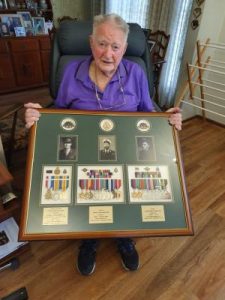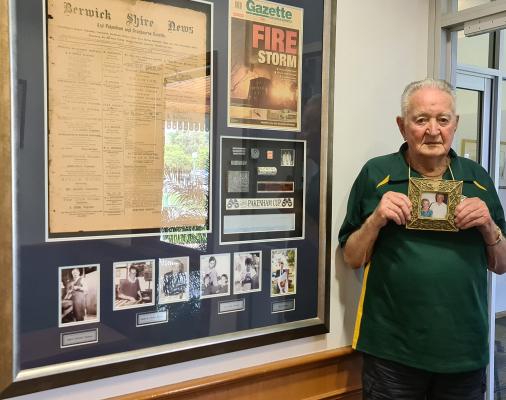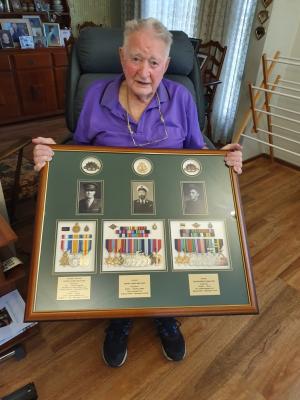It’s hard to sum up a lifetime of memories – particularly when there are 97 years of them. With a mind that’s still sharp as a tack and his sense of humour intact, long-time Garfield resident and Simcocks family patriarch Leslie Mervyn Drayson sat down with reporter DANIELLE KUTCHEL to reflect on a life well lived.
Les was born in 1924, when Garfield and Pakenham were but fractions of what they are now.
Asked whether things have changed much over his lifetime, Les responds enthusiastically: “I’ll say they have!”
And yet, Garfield’s main street is much the same, he admits – just with different faces.
“It was a thriving little town from what I can remember from my early days,” Les explains.
Potato and asparagus growing saw people throng to the district. There was a theatre – a rarity in the district, and something that surrounding towns like Bunyip, Nar Nar Goon, Tynong and Longwarry didn’t have – so there was plenty to keep the families entertained. There was a racecourse too, and dances every weekend.
The population kept Les’ family busy. His parents – Henry James Drayson and Doris, known to all in Garfield as ‘Ma Drayson’ – were postmaster and mistress, responsible for delivering mail across the swamp to towns like Iona, Vervale and Cora Lynn.
Henry moonlighted as the district swimming teacher, not in any official capacity, but simply out of a passion for water safety.
Les explained that his father helped make the swimming spot safer for Garfield’s children by tying ropes to the banks for them to hold onto while they were learning.
“He did it as an honorary business,” Les says.
“He was a great one that everybody had to learn how to swim, he said it was no burden to carry and it might save your life one day.”
Ma Drayson was well known for her caring nature, often sending soups or hot roasts to the elderly and sick, ably helped by her son.
Les reflects fondly on his country childhood, where everybody knew everybody else.
“You daren’t step out of line because everybody would look after each other’s children,” he recalls.
“They’d clip you over the ear and the old policeman would give you a boot up the backside.”
Of course, he was the recipient of a fair few of these punishments: “I was a cheeky blighter!”

Garfield was also where Les met his future wife, Joan.
Their first meeting was actually an altercation. She was writing a telegram and had spelt a word wrong; Les picked her up on it, and she ridiculed him for being a “public school boy”.
Later, they met again while Les was weeding his father’s garden. He was wearing his South Melbourne footy jersey, but “Joanie“, a Carlton girl, barracked for the opposition. It just so happened the two teams were playing each other that weekend.
They exchanged a bit of friendly banter about who would win, and Les challenged Joan to put her money where her mouth was.
“She said, ‘well, what sort of a bet do you want?’ and I said ‘well look, if I win the bet you can shout me to the pictures, if you win the bet, I’ll shout you’. And that’s how it started.”
The couple was inseparable for 74 years. In all that time, they never spent a night apart, despite Les travelling for work. They had four children, but lost two early on. Their surviving children, Michele and Michael, grew to become a teacher and a DJ, respectively.
Joanie passed in September 2019.
Les remembers her as “the greatest woman”.
“She was one of the best dancers in the district too. Half the blokes from Pakenham would come up and you couldn’t get a dance with her because they’d be booking her in because she was so good.”
Despite his “two left feet”, he won Joanie’s heart. The two dated on and off for some time, and Joanie wrote to Les when he went to serve in the war.
“Once when I was home on leave, I never even went and saw her. Next time when I went back, I got a letter from her that more or less dressed me down, ‘aren’t I good enough for you to come and see’!” he laughs.
“We just kept on writing and we sort of got together after the war and about three years went and we were married. I knew she was the one after a while because we just had so much in common … and what we didn’t have, we agreed on anyway!”
Les’ cheekiness carried on while he served in New Guinea. He signed up at just 17 by adding a few years to his age, following in the footsteps of his Anzac father and naval officer brother.
“I was a great one to tell the officers where to go and that wasn’t the right thing to do. I often got extra duties for that,” he chuckles.
He tries not to dwell on the horrors of war. In fact, he told nephew John Simcocks that he was just a telex writer; John only found out 18 years after their conversation that Les had actually served on the frontline.
After the conflict ended, Les was a relieving postmaster – originally, he was supposed to fill in for the existing postmistress for two weeks while she was in hospital, but her death meant his tenure lasted 26 years.
He lived in Pakenham for the first half of his married life, raising the children with Joanie.
When daughter Michele enrolled in university, the family moved to Glen Waverley so she didn’t have to live in student accommodation.
In the meantime, Les was good friends with David Burke of the Victorian Racing Club, who encouraged him to apply for a job with the organisation.
Despite a lack of confidence in his knowledge, Les got the job as the bookmaker’s supervisor – and there he stayed until he was forced to retire by the VRC’s rules at the age of 65.
“I loved every minute of it, I wish I’d been there from the word go. I travelled all over Victoria to parts I’d never seen in my life, and I never knew half of them existed. It was a joy to go to work every day.”
After retiring, Les and Joanie continued to live in Glen Waverley. Occasionally he would help at the picnic races when the VRC had no one on the books to do so.
But it’s been a while now since he’s been to a race meeting, and he’s keen to get to Flemington to see the new grandstand.
Looking back over his 97 years, Les is satisfied with life’s twists and turns. He’s got six grandchildren (plus another one due in a week) and 12 great-grandchildren to keep him entertained these days as they grow up in a world that’s very different to the one he knew as a boy.
“It’s unbelievable what’s happened over the years,” he reflects.
Longevity runs in the family: his brother reached age 84, and his sisters reached their 90s. He is now the sole survivor – but his memories live on thanks to the efforts of John, who is a keen collector and assembler of history. There are plenty of family photos to go through and Les points at pictures of people long gone, recalling their names and occupations with total clarity. Those moments might be gone, but they are preserved in time – both in the photo, and in Les’ memory.








